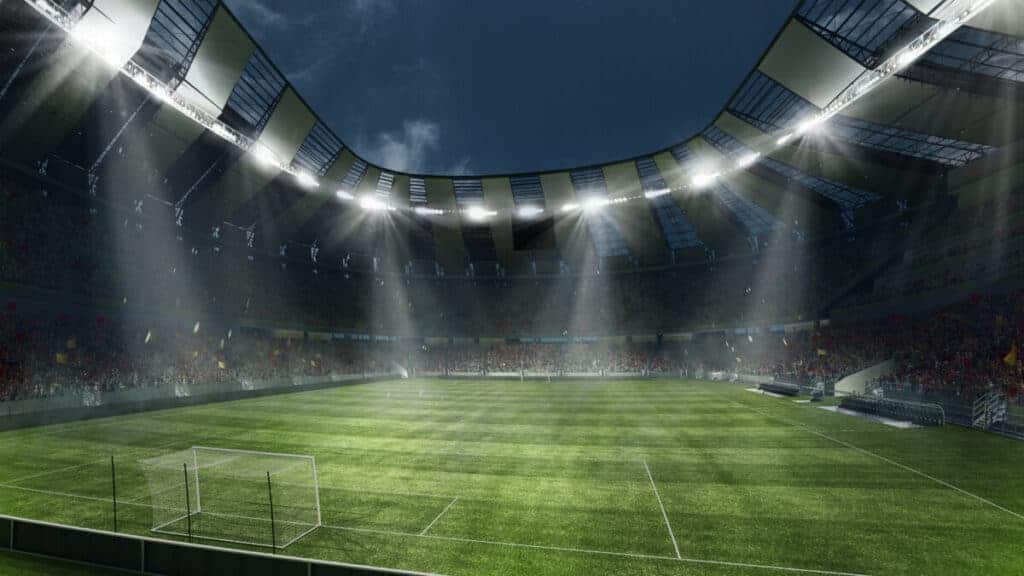How big is a soccer field? [Explained!]
Whether you’re attempting to create a makeshift soccer field in your backyard, borrowing a field at a local park for a soccer game, or you’re simply curious about how big a soccer field is, you’ve come to the right place! We’ve compiled all the measurements you need to know about the average soccer field and size differences across the globe, as well as the minimum and maximum dimensions of a playable field.

A typical and ideal soccer field is 120 yards in length and 75 yards in width, but a soccer field can range anywhere from 100 to 130 yards long and 50 to 100 yards wide. Youth and high school fields are on the lower end of this spectrum, while professional fields are on the higher end.
To learn more about the dimensions of various different soccer fields dimensions, and to learn about why they’re this size, continue reading!
The ideal soccer field

The ideal soccer field is 120 yards or 360 feet long, and 75 yards or 225 feet long. These dimensions are in line with the range for soccer field length and width regulations set by FIFA (Federation Internationale de Football Association) and while 120 yards long and 75 yards wide is the optimal size, many professional soccer fields have various size dimensions that meet the criteria set by FIFA.
The width is determined by how long the goal line is and the length is determined by the distance between one end of the field where one goal sits to the other side of the field where the other goal sits. This distance is typically referred to as the touchline.
Inside the field, the halfway line is going to be the same length as the soccer field width. The radius of the center circle to the center spot is typically going to be 10 yards, so the diameter is a total of 20 yards. Soccer goals are most typically 8 yards long. Penalty areas on both sides are going to be 18 yards in length by 44 yards in width. Goal areas inside these penalty areas are going to be 6 yards in length by 20 yards in width.
The width for both the penalty areas and the goal areas is the side that is parallel to the goal line, while the length is parallel to the touchline (the length of the entire field). The corners, which are marked for players to take corner kicks, have a quarter circle with a radius that is one yard in length. Keep in mind that these interior dimensions are true for every soccer field size, which varies by league and age group.
Maximum and minimum soccer field dimensions
According to FIFA standards, a soccer field must fit between a minimum length of 100 yards and a maximum length of 130 yards, with a minimum width of 50 yards and a maximum width of 100 yards. These dimensions in feet are a length of 300 to 390 feet and a width of 150 to 300 yards.
These are the typical width and length regulations for professional and stadium soccer fields. Although the length and width can technically be the same width and length, a game will typically run more smoothly if the length (the touchline) is significantly longer than the width (the goal line), thus giving the field a rectangular shape.
International maximum and minimum dimensions are a bit more strict. The minimum length for a soccer field by international standards are 110 yards or 330 feet, and a maximum of 120 yards or 360 feet. When it comes to width, the minimum is 70 yards or 210 feet and 80 yards or 240 feet.
This is because many international teams, especially in Europe or Asia, often travel to other countries to play in various home games in the continent, so keeping the lengths and widths the same for these countries helps keep gameplay fair.
Teams inside the United States typically stay inside the U.S. to play against teams in other states, and fields are typically the same size in the states (aside from differing age groups), so players inside the states don’t have to worry about adapting to different-sized fields.
That said, a soccer field can generally fit anywhere between 100 to 130 yards long and 50 to 100 yards wide. All types of soccer fields, including youth soccer fields, high school soccer fields, professional/stadium soccer fields, and international soccer fields fall somewhere within this range.
For younger, more inexperienced teams, they typically play on a field that has shorter dimensions, to help make gameplay easier. For more professional teams, the field length and width are typically on the longer end of the spectrum to help accommodate for the player’s more advanced and refined skills.
What if a field doesn’t fit within the dimension range?

If a field is too small or too large, it can greatly impact gameplay. A field that is too small will make it too easy for teams to make goals, thus making it more difficult for teams to defend their own goals and speeding up the gameplay process. A field that is too large will have the opposite effect, making gameplay too long and difficult for all players.
The reason that fields have regulations in size is so that as teams travel around to play against different home teams, the fields aren’t going to differ very widely and so they don’t have to adapt to the different sizes. It also helps prevent teams who are used to playing on larger fields from dominating any team that is used to playing on smaller fields.
If you want to play a simple game, one that isn’t strictly dictated by soccer rules and required number of players, in your backyard, then you don’t have to worry about the size of your field. The size of your backyard will do just fine for a bit of outdoor fun and practice kicking and dribbling a soccer ball and scoring goals.
Youth soccer fields
Youth soccer fields are typically the smallest size fields in soccer. The dimensions of these youth soccer fields often actually vary by what age group plays on that field, but the youth of all ages can play on any sized youth soccer field, so long as neither team has played on a larger field. Youth soccer fields range from 35 to 55 yards wide and 55 to 80 yards long, and are typically designed for ages 8 to 12. Here are the age groups and their field size dimensions:
| Age group | Number of players per team | Minimum and maximum width | Minimum and maximum length |
| 8 to 10 years old | 7 | 35 to 45 yards or 105 to 135 feet | 55 to 65 yards or 165 to 195 feet |
| 11 to 12 years old | 9 | 45 to 55 yards or 105 to 165 feet | 70 to 80 yards or 210 to 240 feet |
High school soccer fields

In high school soccer, the fields are going to be a bit larger than youth soccer fields but typically still smaller than college soccer fields. The dimensions of a high school soccer field, defined by the National Federation of State High School Associations, is a width of 55 to 80 yards (165 to 240 feet) and a length of 100 to 120 yards (300 to 360 feet).
College soccer fields
In college soccer, the fields are typically larger than a high school field in both length and width, though there are some college fields that are smaller than other high school fields. Outlined by the NCAA men and women’s soccer rules handbook, they are typically between 115 to 120 yards (345 to 360 feet) in length and 70 to 75 yards (210 to 225 feet) in width.
